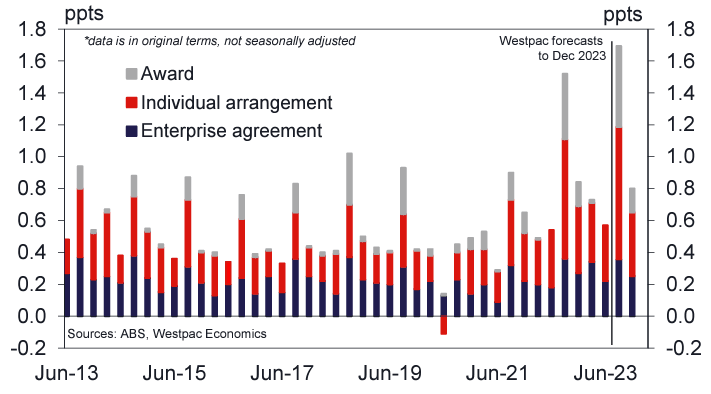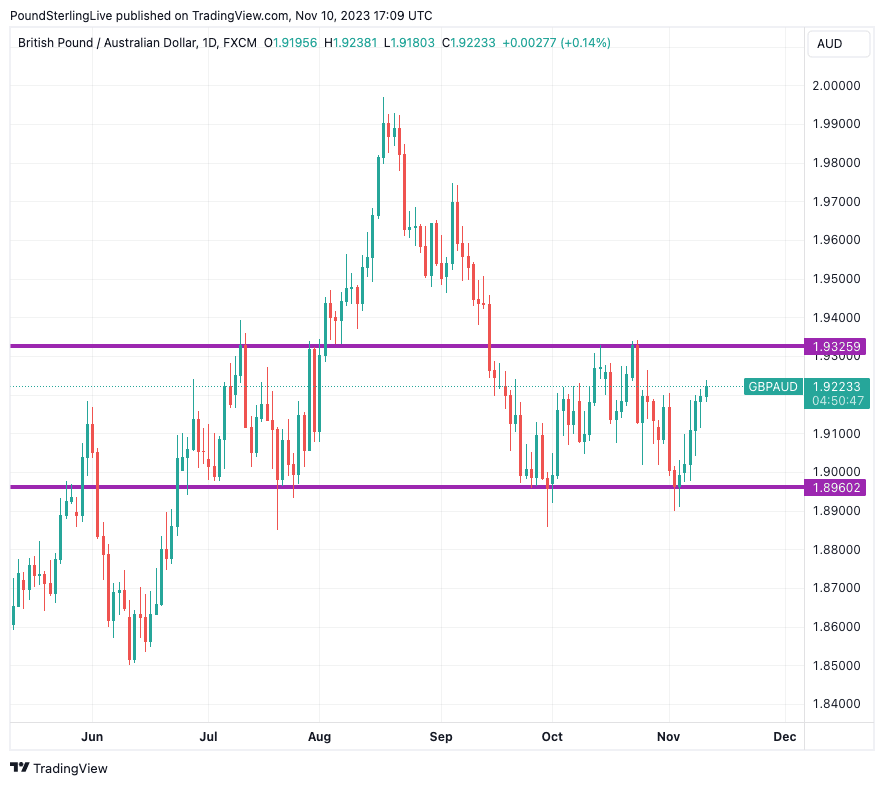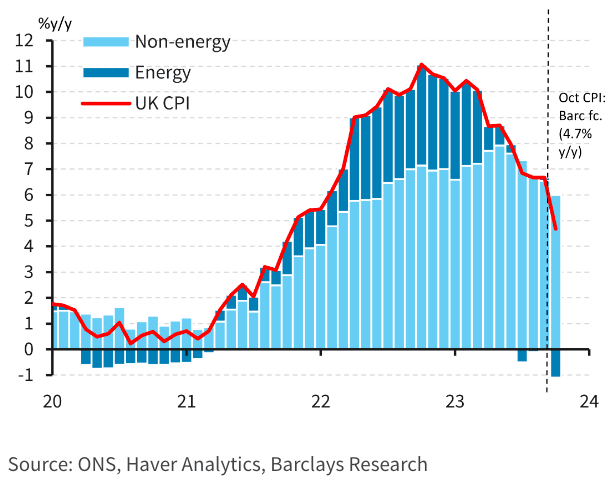GBP/AUD Week Ahead Forecast: Looking to 1.93
- Written by: Gary Howes
- GBPAUD setup is constructive
- AUD weakness proves surprising
- Aussie jobs, wage data in focus this week
- UK inflation numbers in focus

Image © Adobe Images
The Pound to Australian Dollar exchange rate (GBPAUD) can extend a recent rally over the coming days as it builds on recent upward momentum stemming from an apparent crisis of confidence in the Aussie.
The crisis of confidence we mention relates to the curious case of AUD weakness that followed last week's Reserve Bank of Australia (RBA) interest rate hike, which would typically be associated with currency strength.
"The RBA delivered a rate hike that was not fully priced in, but the Aussie has since lost ground on all major crosses, worrying price action," says Richard Franulovich, a currency strategist at Westpac.

Above: AUD performance in the week ending Nov. 10. Set up a daily rate alert email to track your exchange rate OR set an alert for when your ideal exchange rate is triggered ➡ find out more.
The chatter in some financial forums suggests markets have turned cautious on the Aussie's prospects in the event that the RBA has to hike even further, resulting in a 'hard landing' for the economy in 2024.
Pound Sterling has hardly shone over recent days either and was the laggard in G10 alongside the Kiwi and Aussie.
But, the Pound had enough in it to ensure GBPAUD ticked higher, ensuring it can rely on a relatively constructive setup over the coming days.
Above: GBP/AUD at daily intervals.
Compare GBP to AUD Exchange Rates
Find out how much you could save on your pound to Australian dollar transfer
Potential saving vs high street banks:
A$48.75
Free • No obligation • Takes 2 minutes
The above suggests some solid support now lies near 1.8960, and any drop in GBPAUD could be expected to fade here in the short term.
But the upside is preferred at this juncture, and we eye a move to 1.9325.
No doubt, it's a big week for the Australian Dollar from a domestic data perspective, as wage and employment figures will give a decent steer as to whether or not the Reserve Bank of Australia will be obliged to raise interest rates again in the new year.
Tuesday sees the release of the Wage Price Index for the third quarter at 00:30 GMT, with the market looking for a 1.3% rise month-on-month and 3.9% year-on-year, up from 0.8% and 3.6%, respectively.
"Wages data could shift market thinking as the RBA's forecasts imply Q3 wages rose 1.1% q/q. A sizeable beat would have markets lifting the odds of a Feb'24 or May'24 hike," says a note from TD Securities.

Above: Wage inflation contributions - Westpac.
Thursday's labour market figures come out at 00:30 GMT on Thursday with the consensus expecting 18K jobs to have been created in October, up from September's 6.7K.
The unemployment rate is expected to have nudged up to 3.7%.
"Australian wages and labour market data will determine if the RBA will remain a reluctant rate hiker and a weight on the AUD," says David Forrester, Senior FX Strategist at Crédit Agricole.
Above: "Employment growth is gradually moderating" - Westpac.
The FX playbook says upside surprises in the data should support the Aussie Dollar, but given the recent price action, we wonder if the market might baulk at the prospect of further rate hikes.
If this is the case, then it could be a lose-lose for the Aussie.
We would also remind readers to keep an eye on global factors as the Australian currency is highly correlated to global risk.
Chinese data will be of importance to the Aussie Dollar, with markets looking for signs that Australia's most important trade partner is seeing improved activity.
Chinese new loans and money stock figures are out on Monday at 08:00 GMT, while Tuesday sees Chinese industrial production at 02:00 GMT. Consensus is looking for a 4.3% increase year-on-year in October, down from 4.5% previously.
Chinese retail sales can give an insight into the Chinese consumer and a 7.0% y/y increase is expected.
Should Chinese data beat expectations, the Australian Dollar can rally.
Regarding broader sentiment, the U.S. picture will also be key. We note how the NZ Dollar was a major beneficiary of the softer-than-forecast U.S. labour market numbers on November 03, which prompted markets to lower bets for further U.S. interest rate rises.
This outperformance was checked days later when Fed officials maintained guidance that further rate hikes cannot yet be ruled out.
With this in mind, all eyes will be on U.S. inflation figures due midweek, where an undershoot could propel the Aussie higher.
This week is busy with earnings, inflation and retail sales data on tap for the Pound. Earnings are due at 07:00 GMT on Tuesday, with the consensus looking for a reading of 8.3% in September. Should the outcome be above this, the Pound could find some support.
Compare GBP to AUD Exchange Rates
Find out how much you could save on your pound to Australian dollar transfer
Potential saving vs high street banks:
A$48.75
Free • No obligation • Takes 2 minutes
The week's highlight is Wednesday's inflation report, due at 07:00, with the market preparing for a sizeable drop to 4.5% year-on-year from 6.7%.
Should the outcome be above this figure, the Pound could be supported, although we would expect any strength to be limited.
"Inflation data is unlikely to change the direction of travel for the Bank of England and we only expect a minor impact on exchange rates. We hold on to our range-trading theme with a lower limit at the psychological 1.20 resistance level," says Thomas Flury, Strategist at UBS.
Should inflation undershoot, the market would likely boost bets for rate cuts in 2024, resulting in further weakness in the Pound.
"The fall in household energy bills, coupled with base effects, is set to drive a sharp decline in headline inflation in October, though we also expect moderation in core inflation with both core goods and services easing," says Abbas Khan, an economist at Barclays.
Above: "Falling energy contribution the primary driver of the fall in headline CPI in October; but non-energy components to ease too" - Barclays.
"A drop in the Ofgem Price Cap alongside slowing food and core goods momentum should result in headline CPI dropping by close to 200bps," says Sanjay Raja, Senior Economist at Deutsche Bank.
"More disinflation pressure is building. Our own DB Price Survey Tracker points to another 150bps fall by springtime. And our forecasts continue to show headline CPI printing closer to 3% y-o-y by April 2024," he adds.
Above: What the Bank of England is forecasting. Image courtesy of Deutsche Bank.
"For now, we continue to see some downside risks to the Bank of England's CPI projections, which we think should open the door for modest rate cuts by spring time next year," says Raja.
Retail sales are anticipated to have fallen 1.0% in the year to October and 0.9% in the month.
Should the outcome be above these estimates, the Pound could rise, although gains would likely be limited. Instead, risks are tilted to the downside in the event the outcome is below estimate.
"Retail sales were surprisingly soft in September, dropping 0.9% m/m. But we think this is largely noise and expect a decent rebound in October. September's sharp falls in sales in the non-food and non-store categories look particularly odd, and we expect these sectors to have largely made up those losses in October," says Andrew Goodwin, Chief UK Economist at Oxford Economics.








